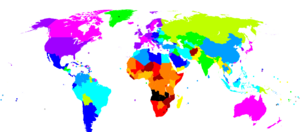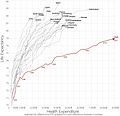Life expectancy facts for kids
Life expectancy is how long a person is expected to live. It's like guessing how many years someone might be alive. This number depends on many things. For example, where someone lives, like their country, makes a big difference. Their lifestyle also matters a lot. This includes things like if they smoke, what kind of food they eat, and if they exercise.
There are big differences in how long people live around the world. This is mostly because of things like public health, medical care, and what people eat. In poorer countries, more people die early because of wars, not enough food, or serious diseases like AIDS and Malaria.
Over the last 200 years, countries in Africa haven't seen the same improvements in how long people live as other parts of the world.
The weather and how information is collected can also affect these numbers. For example, Macau has one of the longest life expectancies in the world, at about 84.4 years. This information comes from the CIA World Factbook.
Differences in Life Expectancy
There are also important differences in life expectancy between boys and girls. In most countries, women usually live about five years longer than men.
How much money people have also affects how long they live. For example, in the United Kingdom, people in rich areas like Kensington live several years longer than those in poorer areas like Glasgow. This might be because of better food, healthier lifestyles, or easier access to doctors and hospitals. It could also mean that people who are very sick are less likely to become wealthy or live in expensive places.
Images for kids
-
This chart shows how life expectancy compares to a country's GDP per person in 2009. This pattern is called the Preston curve.
-
People tend to live longer in rich countries where there is less economic inequality (meaning wealth is shared more evenly).
-
Pink areas show countries where women live longer than men. Blue areas in southern Africa show countries where women have shorter lives, often due to AIDS.
See also
 In Spanish: Esperanza de vida para niños
In Spanish: Esperanza de vida para niños











